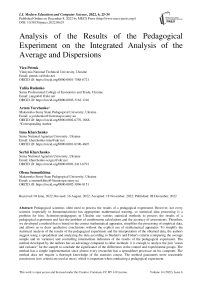Analysis of the Results of the Pedagogical Experiment on the Integrated Analysis of the Average and Dispersions
Автор: Vira Petruk, Yuliia Rudenko, Artem Yurchenko, Inna Kharchenko, Serhii Kharchenko, Olena Semenikhina
Журнал: International Journal of Modern Education and Computer Science @ijmecs
Статья в выпуске: 6 vol.14, 2022 года.
Бесплатный доступ
Pedagogical scientists often need to process the results of a pedagogical experiment. However, not every scientist (especially in humanitarianism) has appropriate mathematical training, so statistical data processing is a problem for him. Scientists-pedagogues in Ukraine use various statistical methods to process the results of a pedagogical experiment and face the problem of cumbersome calculations and the accuracy of assessments. Therefore, we developed a method that is based on the correct mathematical apparatus, simplifies the processing of empirical data, and allows us to draw qualitative conclusions without the explicit use of mathematical apparatus. To simplify the statistical analysis of the results of the pedagogical experiment and the interpretation of the obtained data, the authors suggest using a spreadsheet and analyzing the data according to Student's and Fisher's criteria (comparing the average sample and its variance) and controlling intermediate indicators of the results of the pedagogical experiment. The method developed by the authors has an advantage compared to other methods: it is enough to analyze the pair "mean and variance" for the sample to conclude the significance of the differences in the control and experimental groups. The method has a simple implementation since almost every researcher has a spreadsheet processor on his computer. The method does not require a thorough knowledge of the statistics course. The method guarantees more reasonable conclusions (two criteria are used at once), which is important when conducting a pedagogical experiment.
Pedagogical experiment, pedagogical research, statistical methods, integrated analysis of the average and dispersions, experimental model, specialist training
Короткий адрес: https://sciup.org/15019094
IDR: 15019094 | DOI: 10.5815/ijmecs.2022.06.03
Список литературы Analysis of the Results of the Pedagogical Experiment on the Integrated Analysis of the Average and Dispersions
- K. Arens, “The Structure of Academic Self-Concept: A Methodological Review and Empirical Illustration of Central Models,” The Review of Educational Research, Vol. 91, No 1, pp. 34-72, 2020. DOI: 10.3102/0034654320972186.
- M. K. Budiarto, and T. R. Sudiyanto, “Implementation of Computer-assisted Learning in High School: Teachers and Students “Perspective”,” International Journal of Education and Management Engineering, Vol.11, No (4), pp. 26-34, 2021.
- S. S. De Matas, and B. P. Keegan, “A Case Study on Adult and Workplace Learning,” International Journal of Education and Management Engineering, Vol. 10, No 1, pp. 11-19, 2020.
- J. Glass, and J. Stanley, Statisticheskiye metody v pedagogike i psikhologii [Statistical methods in pedagogy and psychology], M.: Izd-vo «Progress», 1976. (in Russian).
- S.U. Goncharenko, Pedahohichni doslidzhennya: metodolohichni porady molodym naukovtsyam [Pedagogical research: methodological advice for young scientists], Kyyiv-Vinnytsya : DOV «Vinnytsya», 1976. (in Ukrainian).
- M.I. Grabar, and K.A. Krasnyanskaya, Primeneniye matematicheskoy statistiki v pedagogicheskikh issledovaniyakh. Neparemetricheskiye metody [Application of mathematical statistics in pedagogical research. non-paremetric methods], Moskva: «Pedagogika, 1977. (in Russian).
- M. M. Hassan, T. Mirza, and M. W. Hussain, “A Critical Review by Teachers on the Online Teaching-Learning during the COVID-19,” International Journal of Education and Management Engineering, Vol. 10, No 5, pp. 17-27, 2020.
- I. V. Khomiuk, “Systema formuvannia profesiinoi mobilnosti maibutnikh inzheneriv mashynobudivnoi haluzi – The system of formation of professional mobility of future engineers of the machine-building industry,” Ph.D. dissertation, NUBIP of Ukraine, 2013. (in Ukrainian).
- Koeffitsiyent korrelyatsii Pirsona [Pearson’s correlation coefficient], http://hostciti.net/calc/statistics/pearson.html. (in Russian).
- M. Mangla, S. Ambarkar, and R. Akhare, “A study to Analyze impact of social media on society: WhatsApp in particular,” International Journal of Education and Management Engineering, Vol. 10, No 1, pp. 1-10, 2020.
- “Metody pedahohichnykh doslidzhen [Methods of pedagogical research],” Biblioteka on-layn. Kyyiv, MON. http://www.readbookz.com/book/
- D.A. Novikov, Statisticheskiye metody v pedagogicheskikh issledovaniyakh (tipovyye sluchai) [Statistical Methods in Pedagogical Research (Typical Cases)]. M.: MZ-Press, 2004. (in Russian).
- S. Novitsky, “Zahalni pidkhody do otsiniuvannia rezultatyvnosti pedahohichnykh doslidzhen z vykorystanniam informatsiino-tsyfrovykh tekhnolohii [General approaches to evaluation of pedagogical research efficiency using information and digital technologies],” Suchasni informatsiini tekhnolohii ta innovatsiini metodyky navchannia v pidhotovtsi fakhivtsiv: metodolohiia, teoriia, dosvid, problemy – Modern information technologies and innovative teaching methods in training: methodology, theory, experience, problems, pp. 46-54, 2021.
- V. A. Petruk, “Teoretyko-metodychni zasady formuvannia bazovykh profesiinykh kompetentsii u maibutnikh fakhivtsiv tekhnichnykh spetsialnostei – Theoretical and methodological principles of formation of basic professional competencies in future specialists of technical specialties,” Ph.D. dissertation, Natsionalnyi pedahohichnyi universytet imeni M.P. Drahomanova, 2008. (in Ukrainian).
- V.A. Petruk, Formation of the basic level of professional competence in future specialists of technical specialties by means of interactive technologies [Formuvannia bazovoho rivnia profesiinoi kompetentnosti u maibutnikh fakhivtsiv tekhnichnykh spetsialnostei zasobamy interaktyvnykh tekhnolohii]. VNTU, 2011. (in Ukrainian).
- V.A. Petruk, and H.H. Kashkanova, “Probabilistic-statistical models and statistical evaluation of decisions (second supplemented edition) [Ymovirnisno-statystychni modeli ta statystychna otsinka rishen (druhe dopovnene vydannia)],” Navchalnyi posibnyk MON Ukrainy – Textbook of the Ministry of Education and Science of Ukraine, Universum-Vinnytsia, 2006. (in Ukrainian).
- Primer nakhozhdeniya koeffitsiyenta korrelyatsii [An example of finding the correlation coefficient], https://math.semestr.ru/corel/prim.php. (in Russian).
- O.P. Prozor, “Formuvannia kohnityvno-tvorchoi kompetentsii maibutnikh fakhivtsiv iz systemnoi inzhenerii – Formation of cognitive and creative competence of future specialists in systems engineering,” Ph.D. dissertation, Nats. un-t bioresursiv i pryrodokorystuvannia, 2012. http://www.disslib.org/formuvannja-kohnityvno-tvorchoyi-kompetentsiyi-majbutnikh-fakhivtsiv-iz-systemnoyi.html. (in Ukrainian).
- W. J. Rodgers, H. Morris-Mathews, J.E. Romig, and E. Bettini, “Observation Studies in Special Education,”. A Synthesis of Validity Evidence for Observation Systems, 2021. DOI: 10.3102/00346543211042419.
- M. Shyshkina, “Vymohy do zasobiv informatyzatsii naukovo-pedahohichnoho doslidzhennia [Tools of computerization and the structure of scientific pedagogical research planning of scientific researches in aps of Ukraine],” Information Technologies and Learning Tools, Vol. 9, No 1, 2010. DOI: 10.33407/itlt.v9i1.19. (in Ukrainian).
- O. Spirin, T. Novytska, and A. Іatsyshyn, “Elektronna biblioteka yak dzherelo statystychnykh danykh dlia informatsiino-analitychnoi pidtrymky pedahohichnykh doslidzhen [Digital library as a source of statistical data for information-analytical support for pedagogical studies],” Informatsiini tekhnolohii v osviti – Information Technologies in Education, Vol. 35, No 2, pp. 7-26, 2018.


